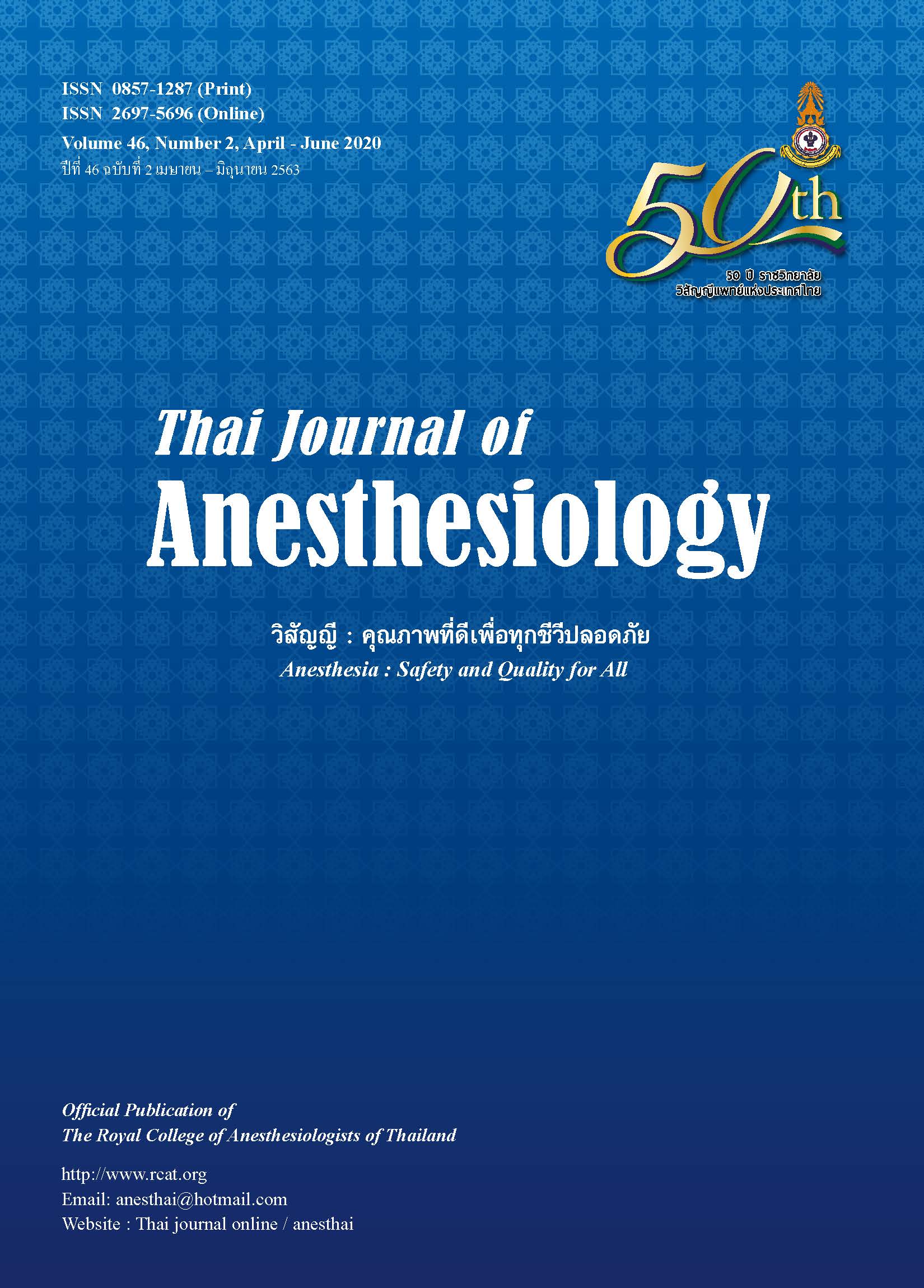Effect of Pre-warming by Forced Air warmer during Total Hip and knee Arthroplasties for Perioperative and Postoperative Hypothermia
Main Article Content
Abstract
Backgrounds: Hypothermia is common problem during
total hip and total knee arthroplasties under spinal
anesthesia. There are many complications such as wound
infections, coagulopathies, respiratory complications,
delayed recovery time and delayed length of stay.
Objective: To study the effect of preoperative warming by
forced air warming device in patients undergoing total hip
or total knee arthroplasties on hypothermia and shivering
during intraoperative and postoperative periods.
Methods: A prospective analytic study in 120 patients
undergoing hip or knee arthroplasties. The patients who
were admitted to the preoperative room were randomized
into 2 groups, preoperative warming group and no
preoperative warming group. Preoperative warming group
using forced air warming device had set 38˚C for 30
minutes. Tympanic temperature was measured on both
groups every 15 minutes in preoperative period until the
patients had discharged from the recovery room.
Results: Preoperative warming group was significantly
less hypothermia than no preoperative warming group
during perioperative (1.7% vs 58.3%; p<0.001) and
postoperative periods (5.0% vs 61.7%; p<0.001). No
patient in preoperative warming group showed shivering.
Preoperative warming group was significantly higher
temperature than no preoperative warming at all points of
measurement.
Conclusion: The study showed preoperative warming
was significantly reduced incidence of hypothermia and
shivering during intraoperative and postoperative periods
in patients undergoing total hip and total knee arthroplasties
under spinal anesthesia.
Article Details
References
normothermia: A meta-analysis of outcomes with costs 1999.
AANA J 1999.67:155-63.
Billeter AT, Hohmann SF, Druen D, Cannon R, Polk HC.
Unintentional perioperative hypothermia is associated with
severe complications and high mortality in elective
operations. Surgery 2014;156:1245-52.
3. Kim YS, Jeon YS, Lee JA, et al. Intra-operative warming with
a forced-air warmer in preventing hypothermia after tourniquet
deflation in elderly patients. J Int Res 2009;37:1457-64.
4. Rajagopalan S, Mascha E, Na J, Sessler DI. The effects of
mild perioperative hypothermia on blood loss and transfusion
requirement. Anesthesiology 2008;108:71-7.
5. Frank SM, Fleisher LA, Breslow MJ, et al. Perioperative
maintenance of normothermia reduces the incidence of
morbid cardiac events: A randomized clinical trial. JAMA
1997;277:1127-34.
6. Lenhardt R, Marker E, Goll V, et al. Mild intraoperative
hypothermia prolongs postanesthetic recovery. Anesthesiology
1997;87:1318-23.
7. Kurz A, Sessler DI, Lenhardt R. Perioperative normothermia
to reduce the incidence of surgical-wound infection and
shorten hospitalization. N Engl J Med1996;334:1209-16.
8. Kurz A. Thermal care in the perioperative period. Best Pract
Res Clin Anaesthesiol 2008;22:39-62.
9. Vassilieff N, Rosencher N, Sessler D, Conseiller C. Shivering
threshold during spinal anesthesia is reduced in elderly
patients. Anesthesiology 1995;83:1162-6.
10. Sessler DI. Complications and treatment of mild hypothermia.
Anesthesiology 2001;95:531-43.
11. Matos JR, McSwain JR, Wolf BJ, Doty JW, Wilson SH.
Examination of intra-operative core temperature in joint
arthroplasty: a single-institution prospective observational
study. Int Orthop 2018;42:2513-9.
12. Simpson JB, Thomas VS, Ismaily SK, Muradov PI, Noble PC,
Incavo SJ. Hypothermia in total joint arthroplasty: a wake-up
call. J Arthroplasty 2018;33:1012-8.
13. Shaw CA, Steelman VM, DeBerg J, Schweizer ML. Effectiveness
of active and passive warming for the prevention of
inadvertent hypothermia in patients receiving neuraxial
anesthesia: a systematic review and meta-analysis of
randomized controlled trials. J Clin Anesth 2017;38:93-104.
14. John M, Ford J, Harper M. Peri-operative warming devices:
performance and clinical application. Anaesthesia 2014;69:
623-38.
15. Rosenkilde C, Vamosi M, Lauridsen JT, Hasfeldt D. Efficacy
of prewarming with a self-warming blanket for the prevention
of unintended perioperative hypothermia in patients
undergoing hip or knee arthroplasty. J Perianesth Nurs
2017;32:419-28.
16. Lau A, Lowlaavar N, Cooke EM, et al. Effect of preoperative
warming on intraoperative hypothermia: a randomizedcontrolled
trial. Canadian J Anesth 2018;65:1029-40.
17. Benson EE, McMillan DE, Ong B. The effects of active
warming on patient temperature and pain after total knee
arthroplasty.Am J Nurs 2012;112:26-33.
18. Wagner D, Byrne M, Kolcaba K. Effects of comfort warming
on preoperative patients. AORN J 2006;84:427-48.
19. WHO guidelines for safe, surgery. 2009.safe surgery saves
lives. Geneva: World Health Organization; 2009.
20. Matsukawa T, Sessler DI, Christensen R, Ozaki M, Schroeder
M. Heat flow and distribution during epidural anesthesia.
Anesthesiology1995;83:961-7.
21. Hynson JM, Sessler DI, Glosten B, McGuire J. Thermal
balance and tremor patterns during epidural anesthesia.
Anesthesiology1991;74:680-90.
22. Matsukawa T, Sessler DI, Sessler AM, et al. Heat flow and
distribution during induction of general anesthesia.
Anesthesiology1995;82:662-73.
23. Just B, Trévien V, Delva E, Lienhart A. Prevention of
intraoperative hypothermia by preoperative skin-surface
warming. Anesthesiology 1993;79:214-8.
24. Horn E-P, Bein B, Böhm R, Steinfath M, Sahili N, Höcker J.
The effect of short time periods of pre-operative warming in
the prevention of peri-operative hypothermia. Anaesthesia
2012;67:612-7.
25. Verra WC, Beekhuizen SR, van Kampen PM, de Jager MC,
Deijkers RLM, Tordoir RL. Self-warming blanket versus
forced-air warming in primary knee or hip replacement:
a randomized controlled non-inferiority study. Asian J
Anesthesiol 2018;56:128-35.
26. Cheon YM, Yoon H. The effects of 30-minutes of pre-warming
on core body temperature, systolic blood pressure, heart
rate, postoperative shivering, and inflammation response in
elderly patients with total hip replacement under spinal
anesthesia: a randomized double-blind controlled trial.
J Korean Acad Nurs 2017;47:456-66.
27. Xu H, Xu G, Ren C, Liu L, Wei L. Effect of forced-air warming
system in prevention of postoperative hypothermia in elderly
patients: A prospective controlled trial. Medicine (Baltimore)
2019;98:e15895.
28. National Collaborating Centre for Nursing and Support Care
(UK). Hypothermia: prevention and management in adults
having surgery. London: Royal College of Nursing (UK); 2016.
29. Min SH, Yoon S, Yoon SH, Bahk JH, Seo JH. Randomised
trial comparing forced-air warming to the upper or lower body
to prevent hypothermia during thoracoscopic surgery in the
lateral decubitus position. Br J Anaesth 2018;120:555-62.


